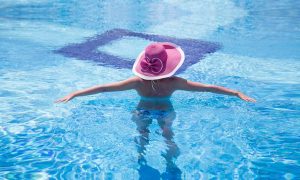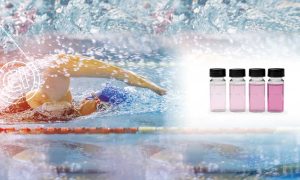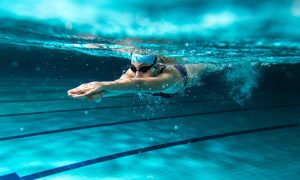Saltwater pools have been a growing industry for both residential and commercial settings. Saltwater pools convert sodium chloride (NaCl) to chlorine without using large amounts of bleach or powder chlorine. This is preferred to traditional chlorination for the physical benefits as well as the healing benefits. Saltwater will not dry out skin, discolor swimwear, harm eyes, or bleach hair. It also can leave the skin with a softer, silkier feeling. Air quality is also improved, as the chlorine smell often associated with pools is not present with saltwater pools. The percent of salt in saltwater swimming pools is typically between 3.3-3.5 ppt NaCl.
Therapy pool and float and isolation tanks are specialized types of saltwater pools that are commonly used for physical therapy and well as mental health. In these types of tanks, the amount of dissolved salt is much higher (as high as 35%), and a mixture of salts such as sodium chloride and magnesium sulphate is used. The high salt content of these pools increases the buoyancy of humans, allowing them to easily float or perform exercises with less resistance than a traditional saltwater pool. Often, these pools or tanks are heated; this brings the water close to the temperature of the skin. Isolation and float tanks are smaller and typically are lightproof as well as soundproof. Stress, anxiety, and migraines have been treated using saltwater isolation or float tanks. Therapy pools are larger and do not have any sensory deprivation components; these types of tanks are used to treat chronic pain and fibromyalgia, as well as in some types of physical therapy due to the ease of movement in the tank.
Application
A physical therapy center contacted Hanna Instruments about monitoring their saltwater therapy pool. They wanted to measure pH and alkalinity weekly, as well as being able to occasionally measure free chlorine and calcium. It was important for them to maintain a pH between to 7.2 and 7.8 and alkalinity of between 80 and 120 ppm CaCO₃. The Hanna sales representative suggested the HI83303 Multiparameter Benchtop Photometer and pH meter and HI11310 pH electrode.

The HI83303 features 20 measurement methods. This includes marine methods for alkalinity and calcium that have been specifically designed for use in seawater and similar saltwater applications. The customer appreciated the built-in timer for colorimetric methods, which made sure the reagents and samples were fully reacted before performing the measurement. Being able to validate the meter was properly working was also important to the customer, but they did not want to have to spend time making standards to test for validation. The included absorbance CAL Check™ standards enabled the customer to check to validate the meter to check the working condition of the light source and photodetectors. The customer appreciated that validation was as easy as placing the meter in absorbance mode and using the associated CAL Check standard to check the wavelengths of light of interest.
Although the HI83303 includes a colorimetric method for pH, the customer appreciated the ability to connect a pH electrode and measure pH potentiometrically for a more accurate measurement. They appreciated the ability to calibrate their probe to two points at pH 7.01 and pH 10.01 to bracket their ideal range of pH 7.2-7.8. Care and maintenance of the pH probe are simple with the pH CAL check alerts, alerting the customer to any potential problems during the calibration process. The customer also utilizes the logging feature, saving the reports from each tank and assigning a sample ID. The HI83303 Photometer and pH meter provided the customer with a comprehensive and affordable solution for their measuring needs.






